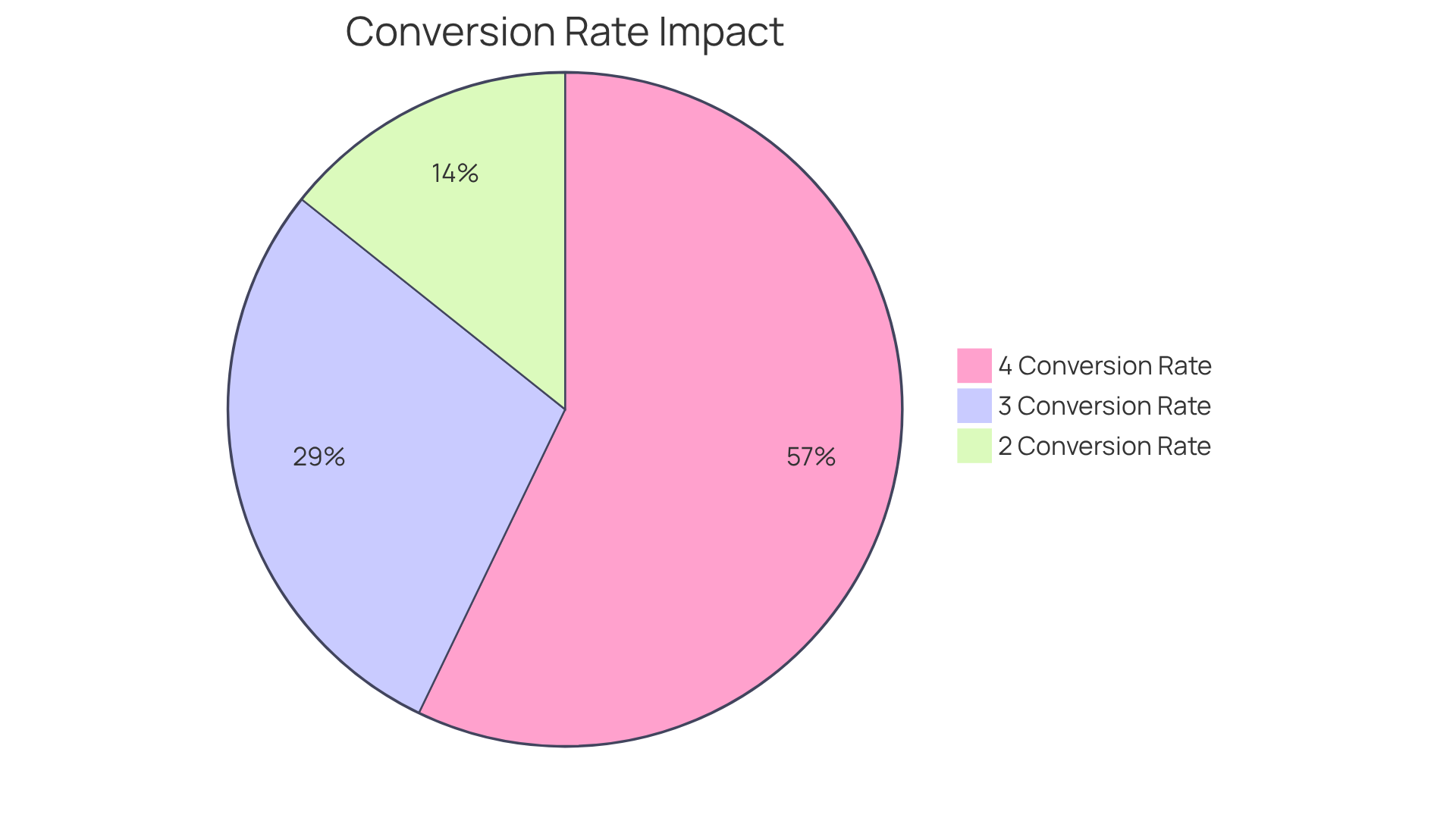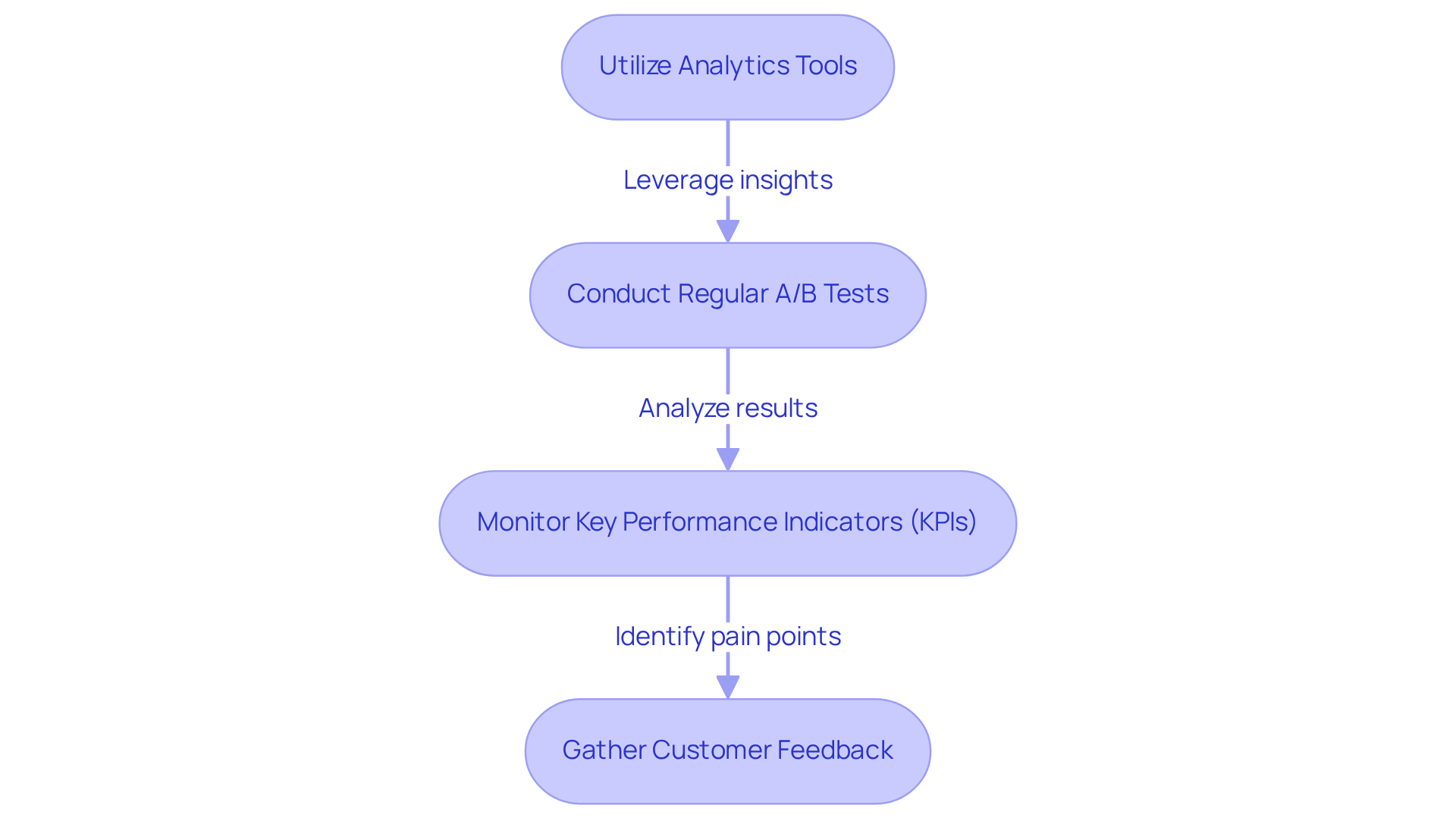
Overview
This article presents proven strategies for boosting page conversion rates, a critical factor for the success of direct-to-consumer (DTC) brands. Implementing effective methods—such as:
- A/B testing
- Clear calls to action
- Enhancing user experience
can significantly elevate conversion rates. These strategies not only drive increased revenue but do so without incurring additional advertising costs. By focusing on these key tactics, DTC brands can achieve remarkable results and strengthen their market position.
Introduction
Understanding the intricacies of page conversion is paramount for direct-to-consumer (DTC) brands striving to excel in a fiercely competitive marketplace. Conversion rates are the linchpin for unlocking substantial revenue growth, and brands must harness proven strategies to elevate both performance and customer experience. Yet, the pressing question persists: how can brands adeptly navigate the complexities of consumer behavior and technology to optimize their conversion potential? This article explores essential techniques and insights designed to empower DTC brands to enhance their page conversions and secure sustainable success.
Understand Conversion Rates and Their Impact on DTC Brands
Understanding the percentage of visitors to a website who achieve by completing a desired action, such as making a purchase, is essential for DTC companies. A healthy conversion rate typically ranges from 2.5% to 4%. Even minor improvements can lead to substantial revenue increases; for instance, a DTC brand attracting 100,000 monthly visitors that elevates its sales rate from 2% to 3% could see an additional $100,000 in monthly revenue, assuming an average order value of $50. This underscores the necessity of implementing effective strategies for page conversion optimization to boost profitability without incurring extra advertising costs.
Parah Group, a leader in page conversion optimization (CRO), advocates for sustainable growth and profitability through customized strategies. Their approach focuses on enhancing search functionalities, as customers who utilize a site's search bar often know exactly what they want and are more likely to achieve page conversion. The average add-to-cart rate in the U.S. is 11%, emphasizing the importance of engaging product pages that drive interaction. Additionally, offering flexible payment options can enhance page conversion by alleviating checkout hesitance, ultimately improving sales rates.
To collaborate with Parah Group, brands must have a minimum of 100,000 website visitors per month and achieve at least 2,000 purchases or conversions monthly. This requirement ensures sufficient traffic and results for effective split testing. Following the establishment of a partnership, an onboarding call with a CRO lead lays the groundwork for long-term growth.
Industry leaders, including Parah Group, assert that effective transformation strategies not only enhance sales but also elevate the overall customer experience during page conversion. Their transformational case studies reveal proven methods that have significantly increased revenue for direct-to-consumer companies. However, businesses should remain cautious of common pitfalls in sales optimization, such as complicating the checkout process or neglecting mobile enhancements, which can hinder page conversion and potential gains.

Implement Proven Strategies to Boost Conversion Rates
To enhance conversion rates, DTC brands must implement the following strategies:
- A/B Testing: Regularly testing variations of landing pages, product descriptions, and calls to action is crucial for identifying which elements resonate most with your audience. For instance, a brand may discover that a green 'Buy Now' button generates higher click-through rates than a red one, ultimately leading to increased sales.
- Clear Calls to Action (CTAs): It is essential to ensure that CTAs are both prominent and compelling. Phrases such as 'Get Yours Now' or 'Limited Time Offer' instill a sense of urgency, prompting immediate action from potential buyers. Effective CTAs can significantly enhance user interaction and improve page conversion results.
- Social Proof: Prominently displaying customer reviews and testimonials on product pages is vital. Research indicates that 79% of consumers as much as personal recommendations, greatly influencing purchasing decisions and enhancing credibility.
- Streamlined Checkout Process: Simplifying the checkout experience by reducing the number of steps required to complete a purchase is essential. Brands that minimize checkout friction can experience sales rate increases of up to 35%, underscoring the importance of optimizing page conversion within the customer journey.

Enhance User Experience to Drive Higher Conversions
Enhancing user experience is crucial for driving sales. Focus on these key areas:
- Website Speed: A mere can lead to a 7% drop in successful transactions. Leverage tools such as Google PageSpeed Insights to pinpoint and address speed issues. Fast-loading pages not only enhance user satisfaction but also contribute to effective page conversion strategies that maximize profitability through diligent testing.
- Mobile Optimization: Given that a significant portion of online shopping occurs on mobile devices, it is imperative to ensure your website is fully responsive and delivers a seamless experience across all platforms. A mobile-friendly website is vital for capturing consumer interest and improving success metrics, particularly when integrated with your paid advertising strategies.
- Intuitive Navigation: Streamline site navigation to enable users to quickly find what they seek. Implement clear categories and a search function to enhance usability. This intuitive design approach is essential in leveraging consumer psychology, making it easier for potential customers to engage with your brand and facilitating a smoother transition from ads to page conversion.
- Visual Design: Invest in high-quality images and a clean layout. A visually appealing site can significantly boost user engagement and encourage purchases. Brands that prioritize aesthetics often observe a direct correlation with success metrics, underscoring the importance of a well-crafted user experience within your overall CRO strategy. By ensuring that your visual design aligns with your marketing initiatives, you can create a cohesive experience that enhances results.

Leverage Data and Testing for Continuous Improvement
To ensure continuous improvement in conversion rates, DTC brands must implement effective strategies that drive results:
- Utilize Analytics Tools: Implement such as Google Analytics and Hotjar to monitor user behavior on your site. These tools are essential for identifying user drop-off points, allowing for targeted improvements that can significantly enhance user experience.
- Conduct Regular A/B Tests: Cultivate a culture of experimentation by consistently testing various elements of your website. This includes experimenting with different headlines, images, and pricing strategies. Regular A/B testing is crucial, as brands employing this method frequently report a 20-40% increase in click-through performance from enhanced creatives, which contributes to effective page conversion. It is vital to isolate one variable per test to ensure clear results and avoid confusion.
- Monitor Key Performance Indicators (KPIs): Maintain a vigilant focus on critical metrics such as bounce rate, average session duration, and cart abandonment rate. These KPIs provide valuable insights into user engagement and highlight areas requiring attention. Statistically valid results from A/B testing typically necessitate 7-14 days, making it essential to analyze these metrics over time. Brands investing over $500K annually in digital ads should prioritize A/B testing marketing to maximize their return on investment.
- Gather Customer Feedback: Actively seek customer insights through surveys and feedback forms. Understanding customer pain points is vital for guiding your optimization efforts and enhancing the overall shopping experience. A/B testing not only identifies which offers resonate best but also enhances page conversion by encouraging deeper analysis of customer behavior, leading to more informed marketing strategies. Additionally, be mindful of common pitfalls in A/B testing, such as low sample sizes or overly similar variants, which can result in inconclusive outcomes. Treat A/B testing as an ongoing habit rather than a one-time project to ensure continuous improvement.

Conclusion
Understanding and optimizing page conversion is pivotal for the success of direct-to-consumer (DTC) brands. By implementing proven strategies and enhancing user experience, brands can significantly increase their conversion rates, translating to higher revenue without incurring additional advertising costs. The journey to improved conversions necessitates a multifaceted approach that incorporates data analytics, A/B testing, and a keen attention to user experience.
Key strategies include:
- The importance of clear calls to action
- Streamlined checkout processes
- The integration of social proof to build trust with potential customers
- Enhancing website speed
- Mobile optimization
- Intuitive navigation
These elements are critical for facilitating a seamless shopping experience. Continuous improvement through data analytics and customer feedback ensures that brands remain agile and responsive to changing consumer needs.
Ultimately, the significance of conversion rates in DTC marketing cannot be overstated. Brands that prioritize these strategies not only enhance their sales figures but also foster a more engaging and satisfying customer journey. Embracing these techniques will empower DTC brands to thrive in a competitive landscape, ensuring sustained growth and profitability.
Frequently Asked Questions
What is a conversion rate and why is it important for DTC brands?
A conversion rate is the percentage of visitors to a website who complete a desired action, such as making a purchase. It is important for DTC brands because even small improvements in conversion rates can lead to significant revenue increases.
What is considered a healthy conversion rate for DTC companies?
A healthy conversion rate for DTC companies typically ranges from 2.5% to 4%.
How can a small increase in conversion rate affect revenue?
For example, if a DTC brand with 100,000 monthly visitors increases its sales rate from 2% to 3%, it could see an additional $100,000 in monthly revenue, assuming an average order value of $50.
What strategies can enhance page conversion optimization?
Effective strategies for page conversion optimization include improving search functionalities, engaging product pages, and offering flexible payment options to reduce checkout hesitance.
What is the average add-to-cart rate in the U.S.?
The average add-to-cart rate in the U.S. is 11%.
What are the requirements for brands to collaborate with Parah Group?
Brands must have a minimum of 100,000 website visitors per month and achieve at least 2,000 purchases or conversions monthly to collaborate with Parah Group.
What is the purpose of the onboarding call with a CRO lead after establishing a partnership with Parah Group?
The onboarding call with a CRO lead lays the groundwork for long-term growth in page conversion optimization.
How can effective transformation strategies benefit DTC brands?
Effective transformation strategies can enhance sales and improve the overall customer experience during page conversion.
What common pitfalls should businesses avoid in sales optimization?
Businesses should avoid complicating the checkout process and neglecting mobile enhancements, as these can hinder page conversion and potential gains.
FAQs











